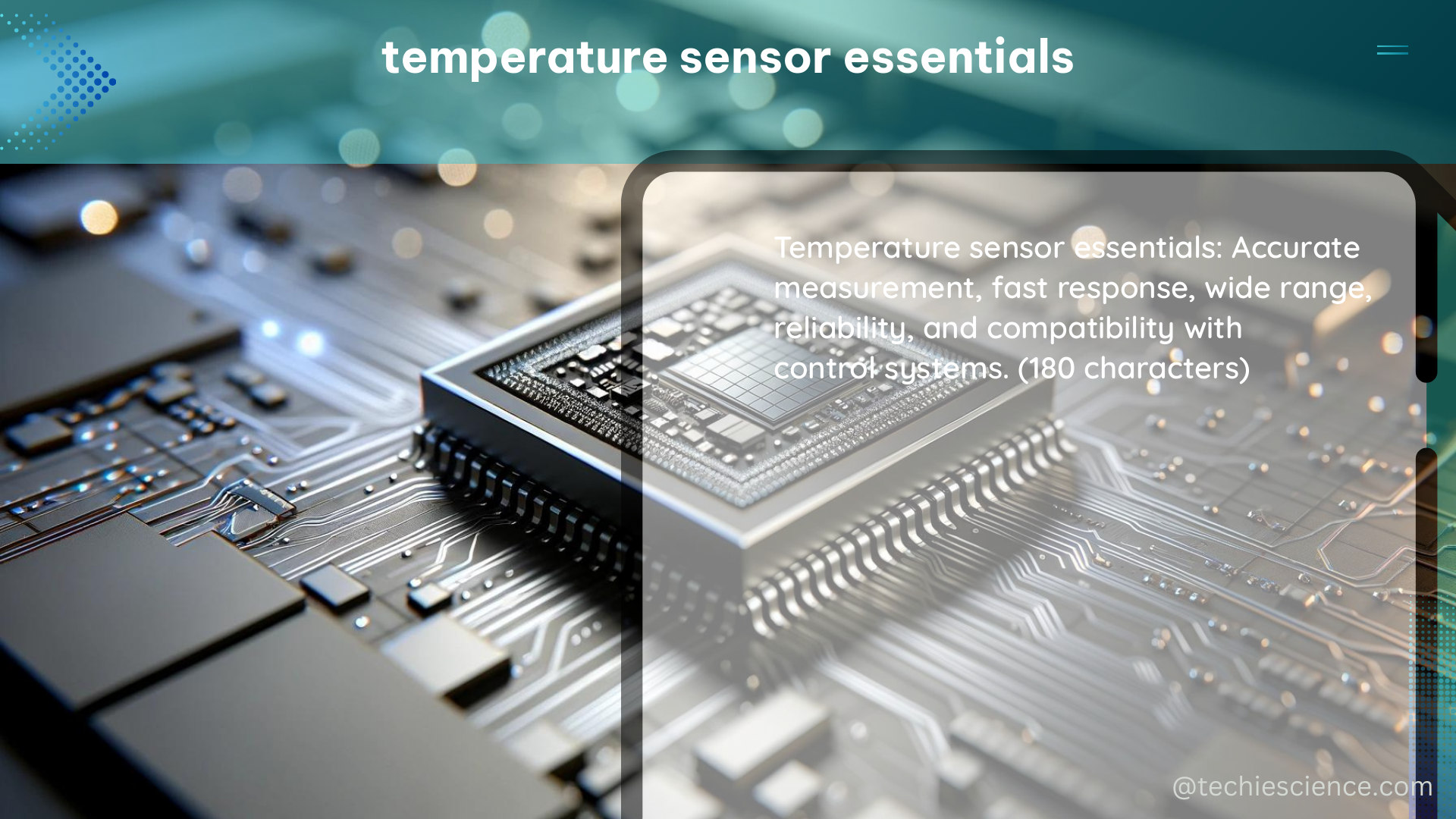Temperature sensor essentials are critical components in various applications, including industrial automation, HVAC systems, and medical devices. These sensors measure temperature and convert it into an electrical signal that can be processed and analyzed. The technical specifications of temperature sensors include their temperature range, accuracy, response time, and power consumption.
Temperature Range and Accuracy
The temperature range of a sensor is the minimum and maximum temperatures it can measure accurately. This range is crucial in determining the sensor’s suitability for a particular application. For example, a temperature sensor used in a medical device may need to measure temperatures ranging from 25°C to 45°C, while an industrial sensor may need to measure temperatures from -40°C to 200°C.
Accuracy is another essential specification of temperature sensors. It refers to how closely the sensor’s measurement matches the actual temperature. Accuracy is typically expressed as a percentage of the full-scale range or as an absolute value, such as ±0.5°C. High-accuracy temperature sensors are essential in applications where precise temperature measurements are critical, such as in medical equipment or scientific research.
| Temperature Range | Accuracy |
|---|---|
| -40°C to 200°C | ±0.5°C |
| 25°C to 45°C | ±0.1°C |
| -200°C to 600°C | ±1°C |
Response Time and Thermal Inertia

Response time is the time it takes for a temperature sensor to respond to a change in temperature. This specification is crucial in applications where rapid temperature changes need to be detected, such as in industrial process control or automotive systems.
Thermal inertia is another important factor that affects a sensor’s response time. Thermal inertia is the resistance of a material to changes in temperature, and it is influenced by the sensor’s size, shape, and construction. Sensors with lower thermal inertia will have a faster response time, allowing them to more accurately track rapid temperature changes.
| Sensor Type | Response Time |
|---|---|
| Thermocouple | 0.1 to 10 seconds |
| Resistance Temperature Detector (RTD) | 0.5 to 30 seconds |
| Thermistor | 0.1 to 5 seconds |
| Semiconductor | 0.01 to 1 second |
Power Consumption and Energy Efficiency
Power consumption is a critical specification for temperature sensors, especially in battery-powered or remote monitoring applications. Low-power temperature sensors are essential in these scenarios, as they can extend the battery life or reduce the energy requirements of the overall system.
Energy efficiency is also an important consideration for temperature sensors, particularly in the context of the growing energy demands of the telecom industry. With the increasing need for data traffic and infrastructure, the telecom industry is expected to consume more energy, potentially doubling or tripling its current consumption. Energy-efficient temperature sensors can help reduce the industry’s carbon footprint and contribute to global sustainability efforts.
| Sensor Type | Power Consumption |
|---|---|
| Thermocouple | 1 to 10 mW |
| Resistance Temperature Detector (RTD) | 5 to 50 mW |
| Thermistor | 1 to 20 mW |
| Semiconductor | 0.1 to 10 mW |
Applications and Use Cases
Temperature sensors are used in a wide range of applications, including:
- Industrial Automation: Temperature sensors are used to monitor and control processes in manufacturing, chemical processing, and other industrial settings.
- HVAC Systems: Temperature sensors are used to regulate the temperature in buildings, ensuring comfort and energy efficiency.
- Medical Devices: Temperature sensors are used to monitor patient temperature in medical equipment, such as thermometers and incubators.
- Automotive Systems: Temperature sensors are used to monitor engine and cabin temperatures in vehicles, ensuring optimal performance and safety.
- Environmental Monitoring: Temperature sensors are used to monitor and analyze environmental conditions, such as in wildfire detection and early warning systems.
Conclusion
Temperature sensor essentials are critical components in various applications, requiring specific technical specifications such as temperature range, accuracy, response time, and power consumption. With the increasing demand for energy efficiency and remote environmental monitoring, temperature sensors play a vital role in reducing carbon footprints and preventing natural disasters. By understanding the key specifications and applications of temperature sensors, engineers and technicians can select the most appropriate sensors for their specific needs.
References:
- Schneider Electric. (2022). 2022 Universal Registration Document. Retrieved from https://www.se.com/ww/en/assets/564/document/394612/2022-universal-registration-document.pdf
- Nokia. (2023). Nokia People and Planet report 2022. Retrieved from https://www.nokia.com/sites/default/files/2023-03/nokia-people-and-planet-2022-sustainability-report.pdf
- Beamex. (2024). Beamex Blog for Calibration Professionals. Retrieved from https://blog.beamex.com

The lambdageeks.com Core SME Team is a group of experienced subject matter experts from diverse scientific and technical fields including Physics, Chemistry, Technology,Electronics & Electrical Engineering, Automotive, Mechanical Engineering. Our team collaborates to create high-quality, well-researched articles on a wide range of science and technology topics for the lambdageeks.com website.
All Our Senior SME are having more than 7 Years of experience in the respective fields . They are either Working Industry Professionals or assocaited With different Universities. Refer Our Authors Page to get to know About our Core SMEs.